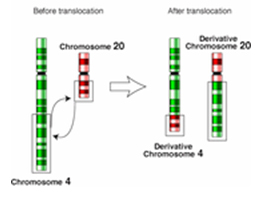A translocation is a change in chromosome structure in which chromosomes are attached to each other or pieces of different chromosomes have been interchanged. An individual with a translocation is unaffected if there is no extra or missing chromosome material and if the break in the chromosome did not disrupt gene function.
If there is no additional or missing chromosome material, the translocation is considered to be "balanced." A translocation is "unbalanced" if there is extra or missing material.

Individuals with balanced translocations typically have no medical issues though some do have fertility concerns, such as reduced fertility.
The concern regarding having a balanced translocation is that, though the individual is healthy, the egg or sperm of that individual can have an unbalanced chromosome make-up that leads to the resultant embryo or pregnancy being unbalanced.
The presence of an unbalanced translocation can lead to an embryo not implanting, a pregnancy being lost or a child being born with mental and physical problems. Individuals with a translocation may, therefore, experience multiple pregnancy losses or have a child affected with physical and mental problems that may be lethal.
It is known that approximately 3 out of 4 (75%) embryos created by IVF will not be capable of producing a live born child. Some will fail to implant in the uterus, while others will implant but are unable to carry out early embryonic development.
Finally, as in natural pregnancy, approximately 15%-20% of conceptions will be lost as a clinical miscarriage. These numbers are often higher when a member of a couple carries a balanced structural rearrangement.
Reciprocal Translocations
Approximately one in 625 individuals has a reciprocal translocation. These translocations involve any of the chromosomes.
Reciprocal defines the translocation as one in which chromosomes have swapped material. Breaks occur anywhere in the chromosomes allowing for pieces to be interchanged between them.
Robertsonian Translocations
Approximately one in 900 individuals has a Robertsonian translocation. It involves the joining of any two of the following chromosomes: 13, 14, 15, 21 or 22.
These chromosomes have a unique structure in that they are primarily made of a bottom half. This translocation results from fusion of two of these chromosomes such that the two bottoms are attached.
Individuals with a Roberstonian translocation have 45 chromosomes, instead of the normal 46, because the two chromosomes stuck together are counted as one.
The most common translocation involves chromosomes 13 and 14 and is seen in about 1 in 1300 persons.